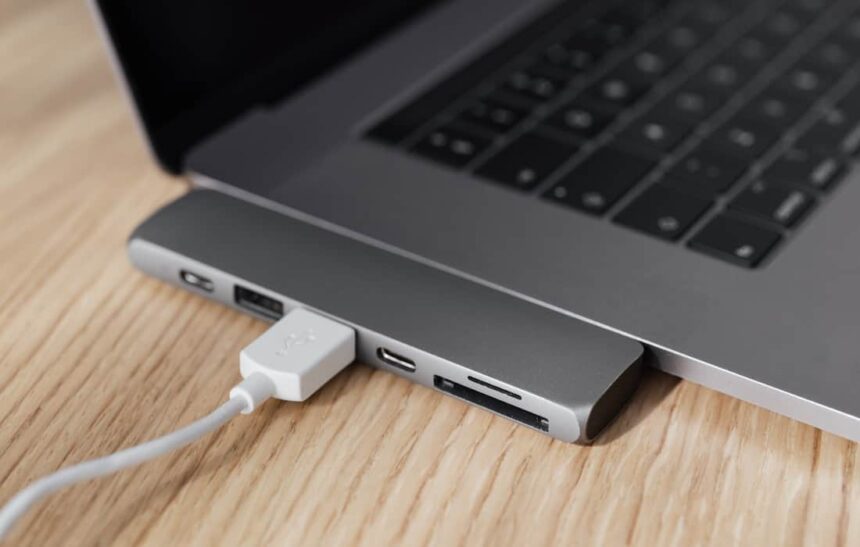USB4 and Thunderbolt 4 walked onto the tech scene practically arm in arm, showing up within a mere year of each other. But hey, don’t be fooled by their close debut dates—these two digital whizzes might have a few things in common, but they’ve got just as many differences that set them apart.
Think about it as a total hardware makeover: your computer’s connections levelling up from basic, one-trick ports to supercharged, all-in-one connectors that can handle a whole bunch of tasks. USB4 and Thunderbolt 4 are the superheroes of hardware evolution. Now, let’s dive into the exciting overlap between these specs and how to distinguish their different attributes.
What Is USB 4.0?

The USB Implementers Forum helped USB 4.0, also known as the stylish USB4, make its tech debut on August 29, 2019. The truth is that USB4 is all about the interface architecture and not about playing around with connector types. Hold on though, there are rules in the Forum, and if you are using USB4, you must use the USB-C connector for your ports and cables. No exceptions!
This is where things really start to pick up. USB4 follows in the footsteps of Thunderbolt 3, a protocol that Intel decided to make royalty-free in 2019. The end result? A whopping 40Gbps bandwidth, and gamers, brace yourselves—USB4 is finally turbocharged enough to support external GPUs. Do not worry if your older technology feels left out; USB4 still gets along with cool kids like USB 3.2 and USB 2.0.
However, there is still more! There are more uses for USB4 than just one. It is like a chameleon, with all these different modes at its disposal. The USB4 package includes Thunderbolt, DisplayPort, and MHL over Alt Mode. However, HDMI Alt Mode from USB 3.0 is no longer supported. And here’s the deal if you are a member of the laptop and dock club: USB4 has a small request for you. Every USB-C port downstream must be equipped with the DisplayPort 2.0 superpower. What does that mean? Prepare to be wowed by some jaw-dropping 8K and 16K videos cruising along at a buttery smooth 60Hz.
Keep your eyes open; the USB4 has more tricks up its sleeve. It is all about DisplayPort and PCIe tunnelling, with the latter serving as the optional cool kid at the party. The outcome? When you have a variety of items to send, you can get faster data transfer rates. And in the power department, USB4’s not messing around either. We are talking about a 7.5W minimum power delivery output, up from 4.5W in USB 3.0. But the big boss status remains the same: max power delivery at 240W.
Oh, and let us not overlook the redesign of the logo. USB4 focuses on being both informative and slick. You can now look at those logos and tell how fast your USB4 Type-C cable is for data transfers and how much power it has to offer. Just take a look at the spec sheet or the ends of your cable. USB4 is not just about high-tech wizardry; it is also about making your life easier.
Also read:
Top 10 Cars Recommended for Nigerian Roads
What Is Thunderbolt 4?

Thunderbolt 4 made its grand debut in January 2020, and dazzled the tech world at the Consumer Electronics Show (CES). Fast forward to July of that year, and there it is, ready to rock your digital universe. Here’s the lowdown: Thunderbolt 4 struts its stuff with the trusty USB-C connector, which is also used by Thunderbolt 3 and USB4. But don’t be fooled – there’s a twist in this story involving USB-C and Thunderbolt.
Thunderbolt 4 isn’t exactly flaunting its upgrades like USB4. It’s being coy by keeping its maximum bandwidth constant at 40Gbps, just like its predecessor, Thunderbolt 3. But here’s the secret sauce: data transfer speeds through those PCIe lanes are doubled, rocketing from 16Gbps to a whopping 32Gbps.
Thunderbolt 4 has a dual superpower, and it all revolves around the displays. Consider rocking not one, but two 4K displays at 60Hz (an upgrade from Thunderbolt 3’s single 4K action), or going big with a single 8K display at the same silky-smooth 60Hz. Also, don’t forget about the charging game. Thunderbolt 4 has some ground rules for laptops and docks: if you want to party with Thunderbolt 4, you need at least one charging port with a minimum power delivery of 15W.
But hold on, there’s more! Thunderbolt 4 has a neat trick up its sleeve called Wake from Sleep. Consider the following scenario: your keyboard or mouse hits the snooze button, but when they’re ready to party again, they can wake up the entire computer. It’s similar to casting a magical spell on your devices. Let us not forget about security. Thunderbolt 4 provides Direct Memory Access (DMA) protection. That’s just a fancy way of saying it prevents sneaky physical DMA attacks and prevents unauthorised access to your valuable memory.
Prepare for a dock extravaganza. Thunderbolt 4 is all about teamwork, with docks supporting up to four Thunderbolt 4 ports, three facing downstream and one facing upstream. What’s more, guess what? Thunderbolt 4 can tango with DisplayPort, PCIe, USB4 (and all previous generations), and it’s even getting along with its older Thunderbolt siblings. The key word here is compatibility.
So, Thunderbolt 4 struts in with a USB-C connector and some sweet upgrades that may not be obvious at first glance. It’s like the tech equivalent of a double agent, working behind the scenes to keep your digital life running as smoothly as possible.
USB 4.0 vs. Thunderbolt 4: Specifications
Here are the specifications of both communication protocols listed side-by-side for easy comparison.
| USB 4.0 | Thunderbolt 4 | |
| Connector | Yes | Yes |
| Minimum PC Bandwidth | 20Gbps | 40Gbps |
| Maximum PC Bandwidth | 40Gbps | 40Gbps |
| Minimum Video Output Requirements | One 4K display | Two 4K displays |
| Minimum Data Transfer Requirements | USB 3.2—10Gbps | PCIe—32Gbps USB 3.2—10Gbps |
| Required Wake from Sleep | No | Yes |
| Intel VT-d based DMA Protection | No | Yes |
| Thunderbolt Networking | No | Yes |
| Minimum Power Delivery (maximum) | 7.5W (240W max) | 15W (240W) |
| Universal 40Gbps cables up to 2 meters in length | No | Yes |
USB4 vs. Thunderbolt 4: Similarities and Differences
Here’s a breakdown of the similarities and differences between USB4 and Thunderbolt 4
| Aspect | USB4 | Thunderbolt 4 |
| Data Transfer Speed | Up to 40 Gbps | Up to 40 Gbps |
| Protocol | Combines USB 3.2 and Thunderbolt 3 | Thunderbolt 3 and USB 4 compatible |
| Backward Compatibility | Compatible with USB 3.2 and earlier | Compatible with Thunderbolt 3, USB 4, and USB 3.2 |
| Alternate Modes | Supports DisplayPort and other alternate modes | Supports DisplayPort, PCI Express, and other alternate modes |
| Daisy Chaining | Yes, supports daisy chaining | Yes, supports daisy chaining |
| Power Delivery | Supports USB Power Delivery up to 100W | Supports USB Power Delivery up to 100W |
| Cables | Uses USB-C connectors | Uses USB-C connectors |
| Compatibility | Widely adopted across devices and platforms | Commonly found on high-end devices |
| Certification | USB-IF certification is required for compliant devices | Intel-certified for Thunderbolt compatibility |
| Cost | Generally lower cost due to wider adoption | May be higher costs due to additional features |
| Performance | Excellent for most consumer and professional use cases | Higher performance, especially for certain professional applications |
Conclusion
There is no question about it. Thunderbolt 4 is superior to USB4, but depending on your preferences, it may not be the best option for you. If you want an interface with the most power and performance, look no further than Thunderbolt 4-enabled hubs, docking stations, and laptops. If you are more concerned with price and have a large selection of accessories to choose from, USB4 may be the best option for you.










